Free shipping on USA orders over $129!
It’s an exciting time in a Charlotte Mason home school when your child turns six years old and you’re ready to start doing set, formal lessons. But how do you begin? You might be able to just jump in and do a full schedule of lessons right from the start. But sometimes you, or maybe your child, might not be ready to go full-out from the first day. So today I want to share some ideas on how you could ease into that first year of formal lessons.
First, let me share three things to keep in mind, then we’ll talk through the practical how to’s.
A Season of Change
Keep in mind that you are entering a season of change, and seasons of change have to do with both outward and inward changes. Yes, you will be changing your daily routine—and I’ll walk you through how to do that—but you will also be walking your child through some internal transitions.
You see, up until this point, during the preschool years, if you’ve been following Charlotte Mason’s methods, you have been doing informal learning activities with your child. That means that you have offered a learning activity, but if your child didn’t want to do it, you didn’t push; you set it aside. You let the child lead the way. That’s as it should be during those early years.
But now you will be encouraging your child to take another step of growth in the habit of self-discipline, of doing something when she knows she ought to whether she feels like it or not. You know from your own experience that growing in this habit can be hard work sometimes; it’s not always easy. Yes, you will try to smooth that path as much as you can by keeping the lessons short, varied, and interesting, but they will still require effort as your child grows in the habit of self-discipline, as well as the habits of attention and best effort. So just be aware of what’s happening on the inside as well as on the outside as you make this change. Use what Charlotte called “all-mighty gentleness” as you help your child walk through the outward changes and the inward transitions.
New Expectations
Take some time to talk to your child about being big enough to start real school lessons and how that will look. Let her know what will be expected of her in this new season.
Here’s something else to keep in mind: be sure to communicate your new expectations. If your child is used to informal activities and being able to take-it-or-leave-it with learning opportunities and suddenly she doesn’t have a choice anymore, it could be very jarring to her. Instead, take some time to talk to her about being big enough to start real school lessons and how that will look. Let her know what will be expected of her in this new season. And if you have any younger children who are old enough to understand, let them know what will be changing too and what you will expect from them: Will they be allowed to join in on certain lessons? When will you be expecting them to play quietly? What will you be expecting them to do during those quiet play times? You can take a look at this post where I spoke with two moms who gave some wonderful ideas for homeschooling with preschoolers in the mix.
The Big Picture
Then, the third thing to keep in mind is the big picture of how to approach these lessons. Charlotte Mason said, “The first things that this school is designed to teach is a love for knowledge for its own sake” (The Story of Charlotte Mason, p. 252). Learning is its own reward. So from the very beginning, set the tone that gaining knowledge is fascinating, is interesting, is exciting for its own sake. Don’t stoop to bribery or threats; be careful not to hold up trinkets or grades or competition as the reason to learn. Instead, model how valuable knowledge is in your own life. Talk about how you love to learn new things and to expand your knowledge. And keep the focus there: a love of knowledge for its own sake.
Your First Year Schedule
All right, let’s talk about your daily schedule and how you can ease into formal lessons a little at a time. This won’t be the only way to do it, but hopefully it will give you some ideas and help you start thinking through what will work best in your situation.
An easy place to start is by doing Scripture memory every day at breakfast and a read-aloud time every afternoon at snack time or every evening at bedtime. Those two habits can just be a part of your family culture. They count for school work, but they can simply be practices that you have chosen to cultivate as a family. And you can start both of them when your children are little. They can form a foundation upon which you build your other lessons.
Once you have those two habits in place, then you might add a 5- or 10-minute reading lesson based on where your child is in the process of learning to read. Those minutes might be spent on activities that help her learn the letters and their sounds or activities that help her start building words or out-and-out reading lessons, moving from individual words to sentences and paragraphs and whole books. The Delightful Reading kits will make those activities simple. If your child is already reading, spend those minutes having her read aloud to you in order to gain fluency. Most likely you were already doing activities like these informally during the preschool years, so the only change is that now there will be a set lesson to do when it is lesson time. But again, you’re going to keep that lesson short and interesting in order to help that child choose to do what she ought, to pay full attention, and give best effort.
You don’t have to do a reading lesson every day. In fact, it can add nice variety if you alternate days between reading lessons and handwriting lessons. Once again, with handwriting lessons, tailor them to where your child is in the process of learning to write. You may spend those moments teaching one stroke and having your child practice it in a pan of rice or sand or on a white board, using her large muscles. After she has mastered a couple of strokes, she can learn how to form the letters that use those strokes. The Delightful Handwriting teacher book will walk you through that process. Then, once she is ready for pencil on paper, you can add the Delightful Handwriting copybook. Those links will be in the notes too. But keep handwriting lessons very short—less than 5 minutes—and focus on quality over quantity.
So at this point your day would look like this:
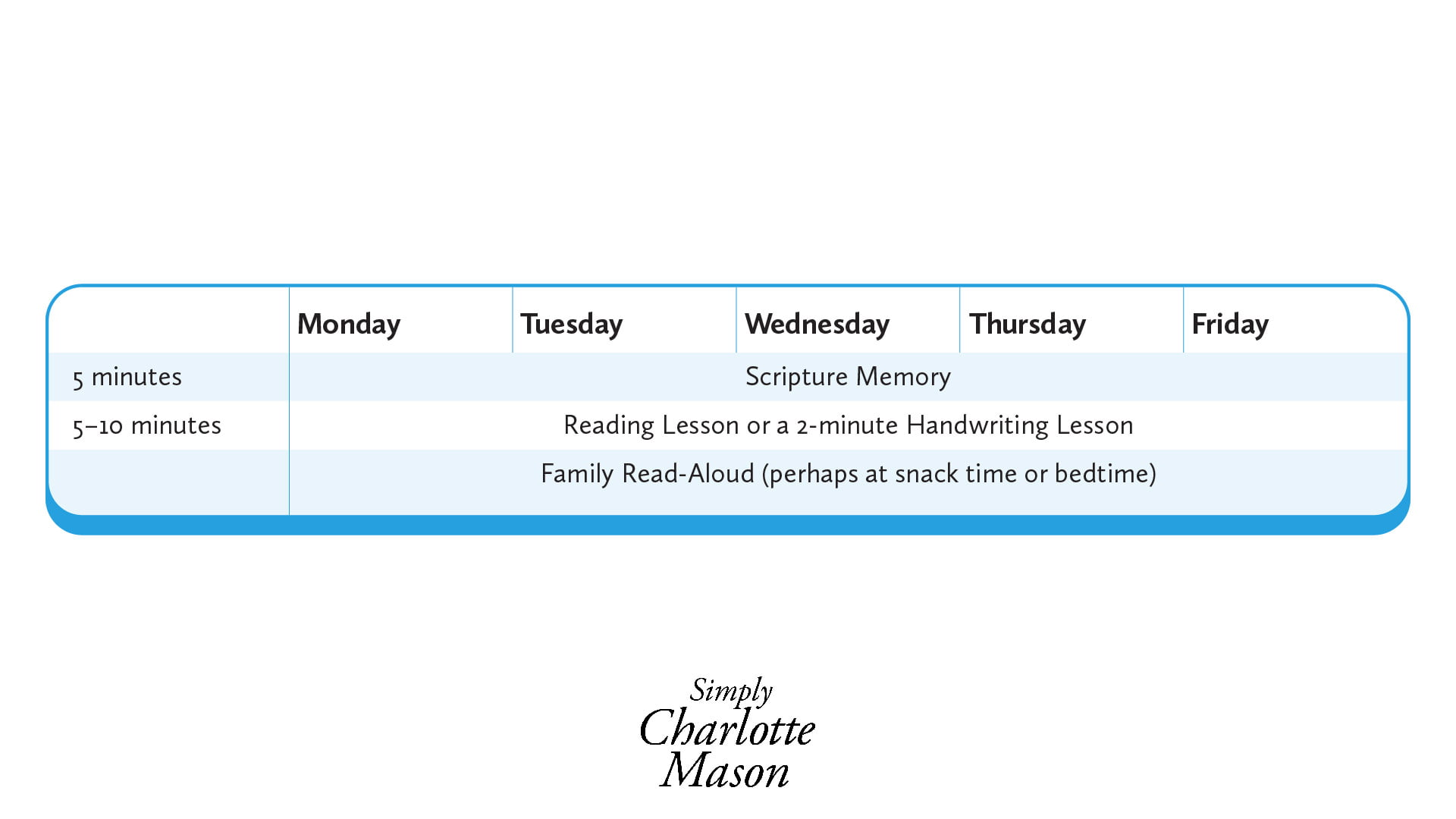

That’s very doable. And the short reading or handwriting lesson can easily take place while any younger children are having a rest time or nap time.
Some Interesting Variety
Now it will be easy to add in one more 5- or 10-minute lesson; and to keep things interesting and offer a nice variety, you’re going do a different type of lesson each day of the week. So on Monday you can do a picture study; on Tuesday you might do a music study; on Wednesday you could read a poem; and on Thursday or Friday let everybody go outside and do nature study.
Now your day would look like this:
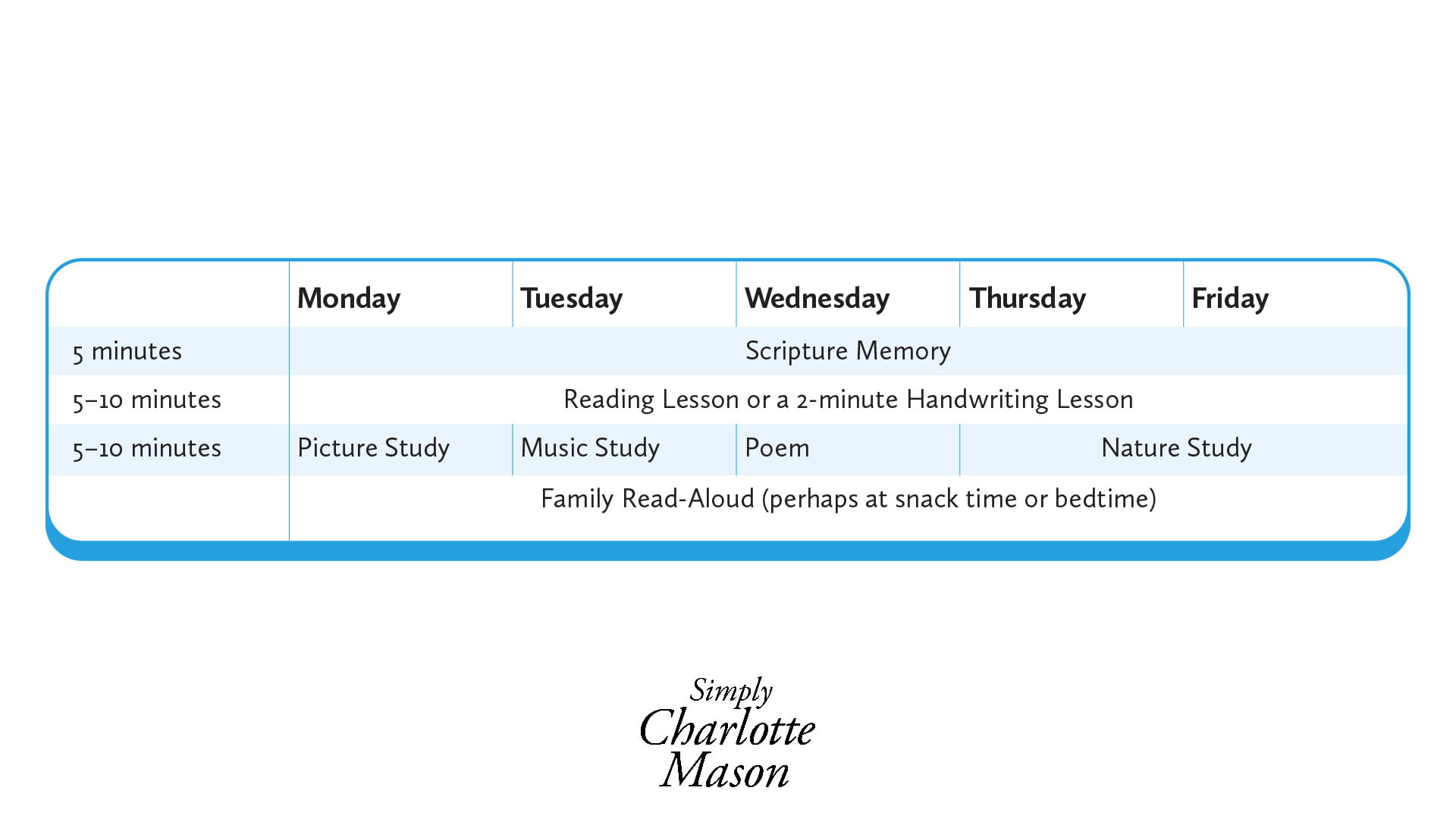

Of course, nature study can go much longer than 5 or 10 minutes. Feel free to stay outside for a while, but any guided or directed focus, encouraging your child to look closely at one nature friend and record what she observed, can still be short.
Adding Math
Math lessons would be great to add in next. With The Charlotte Mason Elementary Arithmetic Series, the lessons are hands-on and lively, with little to no handwriting, and only 20 minutes long. You might not start with the full 20 minutes, and that’s okay. The main thing is to get into a rhythm of doing a math lesson every day. Once you get that rhythm established, you can start gradually increasing the length of the lesson, but only as your child is ready. Remember, the goal is to keep that child’s natural curiosity and desire for knowledge alive and well, and that’s especially important in these early lessons.
Here is what your day might look like with math included:
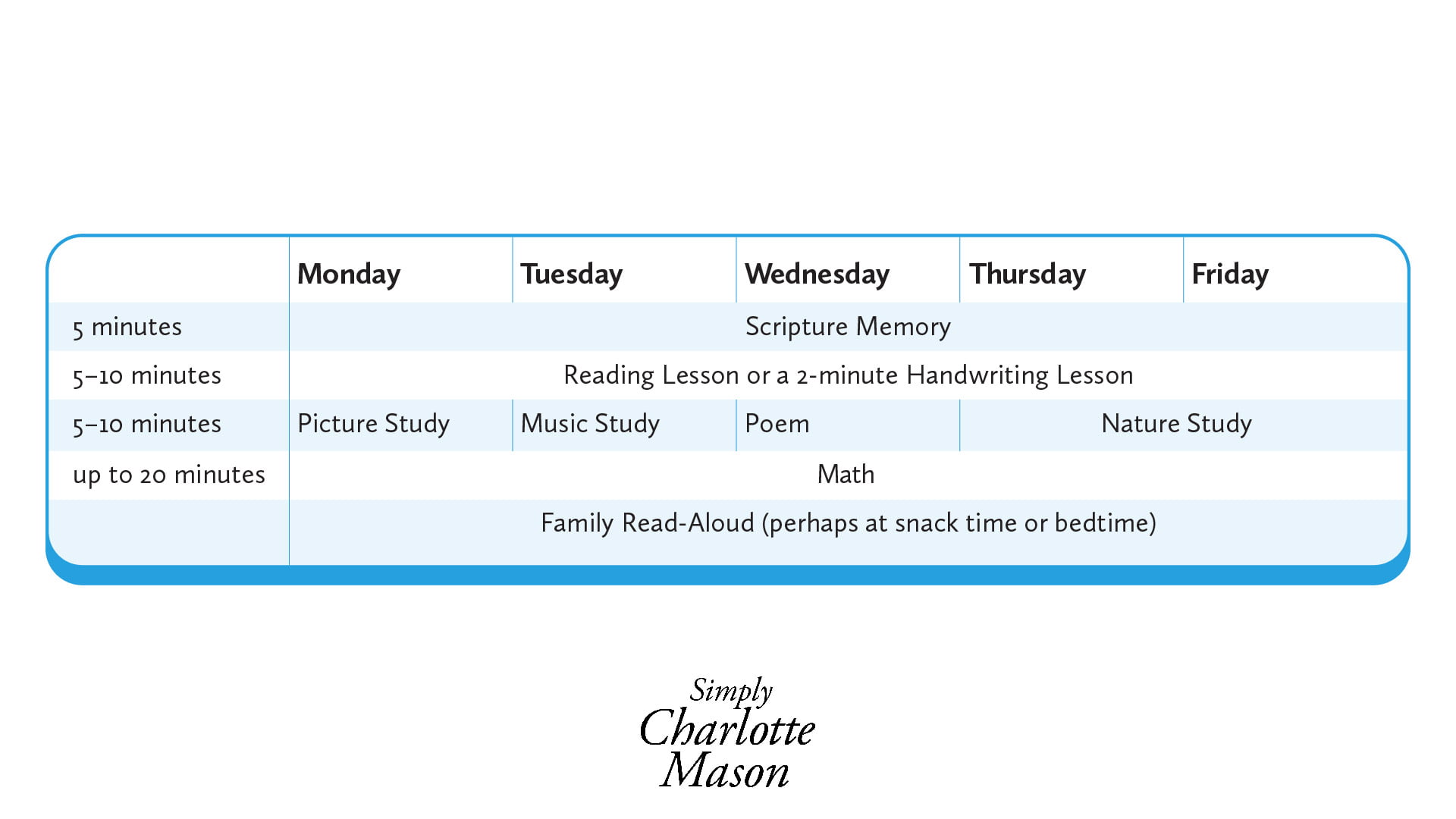

Narration and Geography
At this point you have only a couple of lessons left to add to your day before you’re all in. Next you might add a narration lesson in either history or Bible four days a week and use the fifth day for a geography lesson. Customize these narration lessons to fit your child, just as you did for the reading or handwriting lessons. Start by reading and narrating shorter passages, then gradually increase the length as your child is ready.
You want to use these early lessons to help your child gain a sense of growing confidence. If you push too hard at the beginning, that pressure may cause your child to develop two attitudes that can sabotage the rest of her school years. Those sabotaging attitudes are “I can’t do this” and “I don’t like this.” So tread lightly during these early lessons. It’s much more important to keep the lessons attainable and enjoyable than to check off that you finished this chapter by this date.
Let me just give you a little encouragement on beginning narrations too. Narrating is natural for many children, but it is also a skill. So don’t expect perfection from the start. Look at narrating in the same way as you looked at any other skill that your child learned. How did you view your child’s attempts at learning to walk or learning to talk or learning to use a spoon? Well, view her attempts to narrate in the same way: encourage her, acknowledge the effort she put forth, and calmly watch for growth over time.
All right, once you’ve added a narration lesson, your day might look something like this:
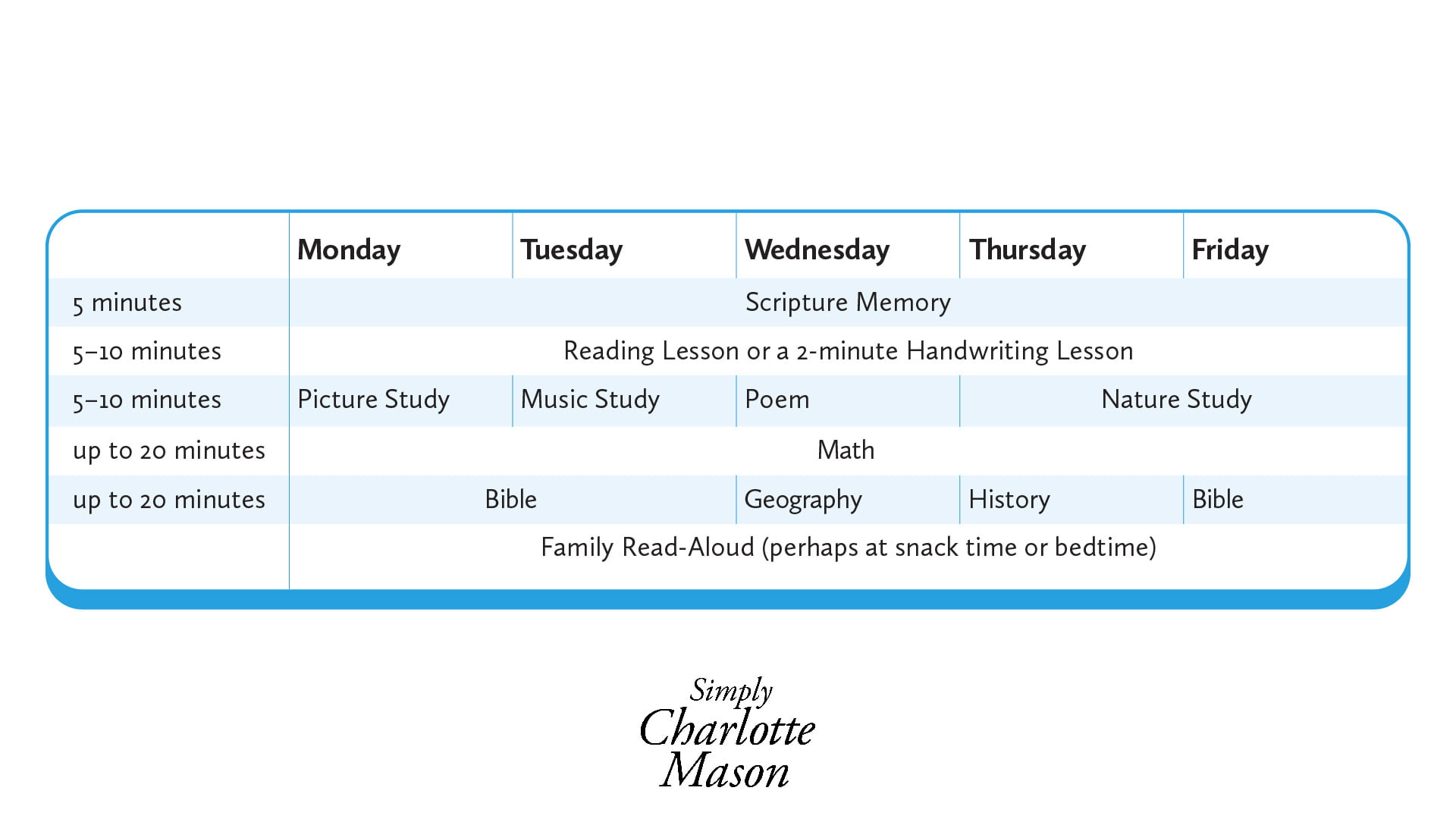

Which days you do Bible, which day you do geography, and which days you do history are up to you. The main thing is to add a narration lesson each day and to keep it varied and interesting.
A Few More Subjects
Now you’re almost there. You’re up to a maximum of an hour and a half per day, spread throughout your day, and all you have left is to add another 20-minute lesson each day. Of course, these will be different types of lessons too, in order to keep that lovely variety of a Charlotte Mason education. That other 20-minute time slot during the day will be for either foreign language, science, or handicrafts. So your complete line-up might look something like this:
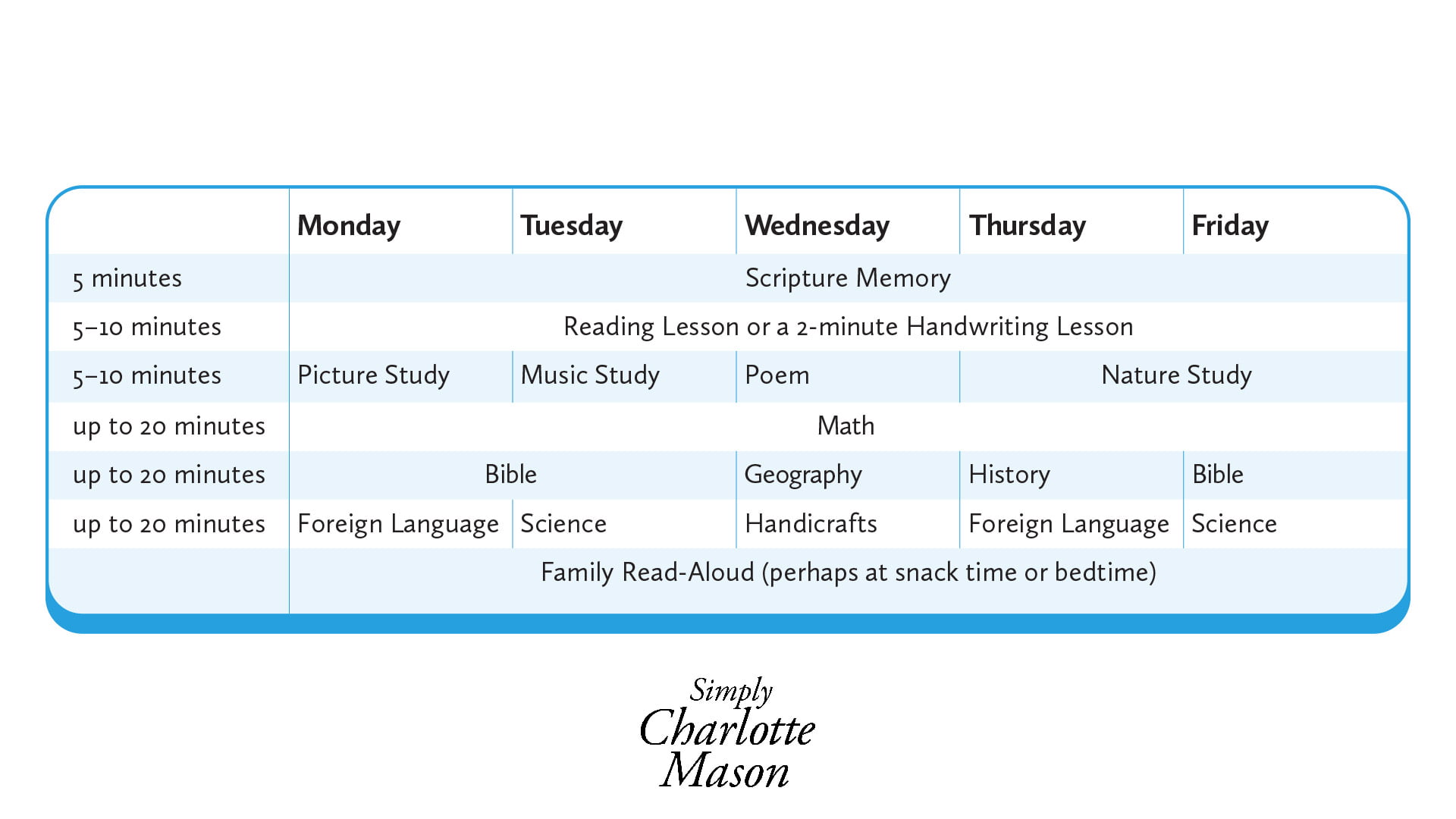

Make It Your Own
Now, you don’t have to do things in this exact order. You have the freedom to rearrange and make the lessons fit your daily schedule. The one thing to keep in mind is that, if you’re going to do two or more lessons back to back with no break, then try to make them two different kinds of lessons. Maybe one lesson deals with words—a reading lesson or a narration lesson; then don’t do a reading or narrating lesson right after that. Mix things up by working with music or a picture or math next. Different kinds of lessons use different parts of the brain. If you keep using one part of the brain for a long time, it will become fatigued and make it very difficult to pay full attention. So arrange your lessons to use different parts of the brain as you work your way through them.
OK, you’re up to an hour and a half or two hours of lessons each day. But remember, this doesn’t have to happen overnight. You can ease into it by adding just one more thing and working with it until you feel settled. Then add one more thing. Be patient. As with any season of change, it’s going to take some practice to get things running smoothly.
So give yourself grace. If it’s been a rough night with the baby or with a time change or with health issues, try to keep that sense of routine going but perhaps don’t do full lessons. For example, you might do only five minutes of math or just a review narration of history, but that little touch will keep the habit of formal lessons continuing even on those challenging days.
And don’t forget that, naturally, as a parent, you’re teaching your child much more than just academics. You are also encouraging her growth in good habits and good character in so many ways. So look at that bigger picture and be sure to give yourself credit for all of the learning that is taking place during chores and free play and trips to the library and church.
Homeschooling your child is a marathon, not a sprint. Don’t feel pressured to do everything perfectly and immediately. Keep your eyes on the big picture. What is it you’re trying to accomplish? Then take the next step in that direction, get it settled firmly in place, and take the next step. The calendar and the clock have nothing to do with your child’s growth as a person. Focus on your child, not some random deadline. Teach the child, and you’ll do just fine.
Podcast: Play in new window | Download
Podcast (podcastv): Play in new window | Download

I saw the handwriting should be 5 minutes. Is that when they first start or should it always be 5 minutes?
Hi Laura. When beginning handwriting lessons you’ll want to keep the lessons shorter than 5 minutes. The goal is for your child to give his best effort even if that is only a few strokes or 1 word. You do not want him to fall into a habit of seeing what Charlotte called “slip-shod” work. You can gradually increase the length of lessons however you’ll never want them to be longer than 10 minutes.
This is just what I was looking for! I have been struggling between my desire to “do all the things” and my desire to ease in as we learn what our schedule will look like at this stage of the game. Thank you!
Excellent. Well thought out plan.
This is such a great reminder even for those of us who have been homeschooling a while. Thank you! Do you have any suggestions for easing older students back into the school year?
Hi Heather. The start of a school year is filled with excitement but can also be hard to get back into the routine after a summer of ease. Often, it can be helpful to begin with a few subjects at a time and slowly add more subjects to the load. Maybe the first week you begin working on morning routines and the enrichment subjects (read aloud, poetry, picture study, etc) and then the following week you might introduce a few individual subjects (math, science, language arts) and the week after that incorporate the rest of your subjects (Bible, history, geography).
Thank you for these encouraging and helpful suggestions. I’ve watched/listened several times now and have taken notes. The way you’ve outlined a gradual build-up to a “full” day has eased my anxiety. –Anne
This was one of the most helpful posts! So encouraging and practical. I can do this!
Any picture book recommendations about starting homeschool or learning?
What a wonderful idea! We do not have any recommendations for picture books that present the idea of starting homeschool or learning.
Thank you for this! Truly! What wonderful, practical advice! And how encouraging and inspirational! I feel like I really *can* do this. 🙂 Thank you for your work in bringing true and eternal principles into every part of the education!
Thank you, Kate, for your kind feedback on the advice shared in this post. You’re right! You’re not alone and you really CAN teach your children well.
Thank you for this post! I’ve been researching homeschooling since my 5 year old was 3 and finally, thanks to this article, it’s all starting to click. So very helpful and encouraging!
One question you might be able to provide advice on… my son’s 6th birthday is in December. Do I start his first year this fall while he is still 5 years old? Should I wait until spring? Or wait another year until next fall? My Charlotte Mason friends have advised I not push it and keep it at an informal, child-led learning pace until he is almost 7. He is eager to learn, incredibly curious, and bright. I never want him to lose the joy he already has from gaining knowledge.
Hi!
Charlotte Mason did advocate to not start formal lessons until the age of 6. However, you know your child best. If you think he would be interested in gentle reading writing, and math lessons, you could explore those with him as you think he is ready. Charlotte wrote of a 2 year old child learning his alphabet and said “there is nothing against it so long as the finding and naming of letters is a game to him. But he must not be urged, required to show off, teased to find letters when his heart is set on other play.” (Home Education, pg 202). The principle is that you want these early lessons to be easy and inviting. Sonya has some helpful videos on early academics on this blog post: Preschool Academics.
As far as when to begin, you know your child best. You might want to begin exploring gentle reading, handwriting, and math after the New Year and start formal lessons the following Fall when your child is almost 7– there is no right or wrong. Happy learning!